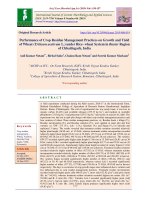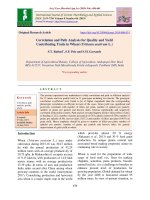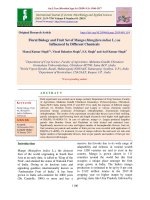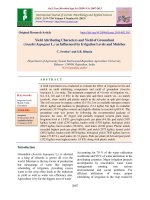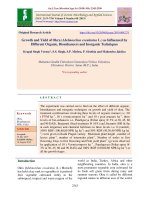Productivity and quality of wheat (Triticum aestivum L.) as influenced by different levels of potassium and nitrogen fertilization
Bạn đang xem bản rút gọn của tài liệu. Xem và tải ngay bản đầy đủ của tài liệu tại đây (274.69 KB, 6 trang )
Int.J.Curr.Microbiol.App.Sci (2018) 7(8): 3631-3636
International Journal of Current Microbiology and Applied Sciences
ISSN: 2319-7706 Volume 7 Number 08 (2018)
Journal homepage:
Original Research Article
/>
Productivity and Quality of Wheat (Triticum aestivum L.) as Influenced by
Different Levels of Potassium and Nitrogen Fertilization
Tangit Longkumer* and Thomas Abraham
Sam Higginbottom University of Agriculture, Technology and Sciences,
Allahabad, 211007, Uttar Pradesh, India
*Corresponding author
ABSTRACT
Keywords
Productivity,
Potassium,
Nitrogen, Quality,
Wheat
Article Info
Accepted:
20 July 2018
Available Online:
10 August 2018
A field experiment was conducted at Crop Research Farm (CRF), SHUATS,
Allahabad, during the Rabi season of 2017 with 12 treatments replicated thrice in
randomized block design, to study the productivity and quality of wheat (Triticum
aestivum L.) as influenced by different levels of potassium and nitrogen fertilization.
Yield attributes and yield exerted significant variation due to application of different
levels of potassium and nitrogen. The result revealed that treatment T8 (60 kg K2O +
120 kg N ha-1) was found to be maximum for no. of grains spike-1 (52.13) and test
weight (49.87 g). Grain and Straw yield (6.30 t ha-1 and 8.94 t ha-1 respectively) were
found to be highest in treatment T11 (90 kg K2O ha-1+ 120 kg N ha-1). Regarding the
grain quality of wheat, the highest protein content (11.81 %) was recorded from
treatment T8 (60 kg K2O + 120 kg N ha-1).
Introduction
Wheat (Triticum aestivum L.) is the most
important and widely cultivated food crop in
the world. In India, wheat is the second
important cereal crop, first being Rice. It
contributes nearly one-third of the total food
grains production. It is consumed mostly in
the form of bread as “Chapati”. Wheat straw
is used for feeding cattle. Wheat contains
more protein than other cereal and has a
relatively high content of niacin and thiamine.
It is basically concerned in providing the
characteristics substance “Glutin” which is
very essential for bakers. Wheat is the second
most staple food grain in Indian diet and main
source of protein and calories for large section
of population. By 2020, India will have a
population of about 1.3 billion and there will
be a substantial pressure on land to produce
more food. Stagnation in wheat production,
lower productivity and inferior quality of the
produce is due to various constraints
including inadequate and imbalanced nutrient
application (Prasad, 2012).
3631
Int.J.Curr.Microbiol.App.Sci (2018) 7(8): 3631-3636
Potassium (K) is the third most important
macronutrient required for plant growth, after
nitrogen (N) and phosphorus (P), and is one
of the principle plant nutrients underpinning
crop
yield
production
and
quality
determination. As potassium is involved in
many physiological processes, its impact on
water relations, photosynthesis, assimilate
transport, and enzyme activation can have
direct consequences on crop productivity
(Pettigrew, 2008) by regulating the opening
and closing of stomata and therefore
regulating moisture loss from the plant. For
this reason, potassium is colloquially known
as “poor-man‟s irrigation” because it assists
crops to achieve yields more effectively
(SQO, 2015). The requirement for K varies
from plant to plant and from species to
species. For example, wheat requires K for
optimal growth and development while
adequate K results in superior quality of the
whole plant due to improved photosynthetic
efficiency, increased resistance to some
diseases, greater water use efficiency, and
helps to maintain a normal balance between
carbohydrates and proteins. Sufficient K
results in stronger wheat straw and assists in
grain filling (Agri-News, 2012).Balanced
fertilizers are essential for the enhancement of
the yield. Nitrogen fertilizer is basically used
for better seed development, seed maturity
and grain production. Nitrogen is most often
the limiting nutrient for plant growth and
development (Andrews et al., 2004). Grain
yield and quality of wheat is improved by the
foliar application of nitrogen fertilizer,
Rozsypal (1989).Therefore, an experiment
was conducted to study performance of wheat
with different levels of potassium and
nitrogen fertilization in terms of yield
attributes, yield and quality.
Materials and Methods
The experiment was carried out at Crop
Research Farm, Department of Agronomy,
Naini Agricultural
Allahabad (U.P.).
Institute,
SHUATS,
The area is situated on the south of Allahabad
on the right hand of rivers Yamuna at Rewa
Road at a distance of about 7 km of Allahabad
city. Allahabad has sub-humid sub-tropical
climate with the monsoon commencing from
July and withdrawing by the end of
September. The rainfall is unevenly
distributed and most of it is received between
July and September.
Apart from this, a few winter and summer
showers are also received. The soil of the
experimental field was sandy loam in texture
with pH 7.6, low in organic carbon 0.42%,
available P 13.50 kg/ha and available K
257.04 kg/ha. This experiment was conducted
in year 2017-18 during the Rabi season and
wheat variety „SHIATS-W6‟ was sown on
15th November, 2017.
The experiment consisted of four potassium
levels, viz. 0 (Control), 45, 60 and 90 kg K20
/ha and three nitrogen levels, viz. 90, 120 and
150 kg N/hawith 12 treatments replicated
thrice in randomized block design.
A common dose of phosphorus @ 60 kg/ha
was applied through single super phosphate,
at the time of sowing. Half of nitrogen was
applied as basal dressing at sowing and rest
half of nitrogen was top-dressed at the time of
first irrigation at the crown root initiation
stage of crop. The crop received six uniform
irrigations. Potassium and nitrogen was
applied through muriate of potash and urea
respectively, as per treatments. Other
agronomic management practices were
followed as per the standard recommendation.
Crop was harvested in the last week of March.
The data on various, yield attributes and yield
were recorded in different treatments. All the
data were statistically analyzed.
3632
Int.J.Curr.Microbiol.App.Sci (2018) 7(8): 3631-3636
Results and Discussion
Yield attributes
Number of grains per spike
Number of grains spike-1is an important yield
contributing parameter and has a direct
bearing on the final grain yield of wheat. The
data as presented in Table 1 showed that there
was a significant difference within the
treatments for number of grains spike-1.
Treatment T8 (60 kg K2O ha-1 + 120 kg N
ha-1) recorded significant and highest number
of grains spike-1 (52.13). However, except for
control, all other treatments were statistically
at par with treatment T8 (60 kg K2O ha-1 + 120
kg N ha-1). Application of potassium
improved the number of grains spike-1which
might be due to the favourable effects of
potassium on nutrient uptake, photosynthetic
activity, improving its mobilization (Arif et
al., 2017). These results are in close
agreement with the findings of Jan et al.,
2012. Meynard, 1987 reported that the
number of grains spike-1is the best indicator
of wheat response to nitrogen and that grains
spike-1is negatively affected by nitrogen
deficiency. Iqtidar et al., (2006) also reported
similar findings.
rate of the crop and material transition in
phloem, grain filling process and facilitates
the quick transportation of nutrients and
assimilates towards the grain which increase
the test weight (Akhter, 2016). It was
observed that the crop receiving higher levels
of nitrogen fertilizer produced bolder grains
and hence higher test weight was obtained
(Farooq et al., 2018).
Yield
Grain and straw yield of wheat increased
significantly with the application of potassium
and nitrogen fertilization. Treatment T11 (90
kg K2O ha-1+ 120 kg N ha-1) resulted in
significant and highest increase in grain and
straw yield (6.30t ha-1 and 8.94t ha-1
respectively). However, treatment T7 (60kg
K2O ha-1+ 90 kg N ha-1) and T10 (90 kg K2O
ha-1+ 90 kg N ha-1) were found to be
statistically on a par with treatment T11 (90 kg
K2O ha-1+ 120 kg N ha-1). The increased yield
with the potassium fertilization might be due
to increased availability, absorption and
translocation of potassium nutrient. As
potassium is essential for grain development,
the favourable effect of high doses of
potassium on yield attributes was mainly
responsible for higher grain and straw yields
(Singh et al., 2015) (Table 2).
Test weight
The data as presented in Table 1 revealed that
potassium and nitrogen fertilization had a
significant effect on grain weight. Treatment
T8 (60 kg K2O ha-1+ 120 kg N ha-1) resulted
in significant and highest increase in test
weight (49.87 g). However, treatment T4
(45kg K2O ha-1+ 90 kg N ha-1), T5 (45kg K2O
ha-1+ 120 kg N ha-1), T9 (60 kg K2O ha-1+ 150
kg N ha-1), T11 (90 kg K2O ha-1+ 120 kg N
ha-1) and T12(90 kg K2O ha-1+ 150 kg N ha-1)
were found to be statistically at par with T8
(60 kg K2O ha-1+ 120 kg N ha-1).Adequate
potash supply increased the photosynthetic
The increase in grain yield with the
application of nitrogen can be ascribed to
better plant growth and dry matter production
due
to
higher
photosynthetic
area
(Satyanarayana et al., 2017). The results were
in corroboration with the findings of Sharma
and Manohar, 2002. Increase in straw yield
with the application of nitrogen probably
came through favourable influence of
nitrogen on growth parameters in terms of
plant height, number of tillers, dry matter
production and LAI (Patra and Ray, 2018).
Similar findings were reported by Beheraa
and Rautaray, 2010.
3633
Int.J.Curr.Microbiol.App.Sci (2018) 7(8): 3631-3636
Table.1 Effect of potassium and nitrogen fertilization on yield attributes and yield of wheat
Treatment
Yield attributes
Yield
No. of grains
spike-1
Test weight
(g)
Grain yield
(t ha-1)
Straw yield
(t ha-1)
42.13
45.67
4.77
6.82
T1
Control+ 90 kg N ha-1
T2
Control + 120 kg N ha-1
34.13
46.00
4.55
6.31
T3
-1
Control + 150 kg N ha
42.80
46.67
3.86
5.37
T4
45kg K2O ha-1+ 90 kg N ha-1
48.13
48.00
3.93
5.37
T5
45kg K2O ha-1+ 120 kg N ha-1
50.80
48.67
4.71
6.44
T6
45kg K2O ha-1+ 150 kg N ha-1
45.07
47.00
4.84
6.74
T7
60kg K2O ha-1 + 90 kg N ha-1
50.00
47.33
5.46
7.79
T8
60 kg K2O ha-1+ 120 kg N ha-1
52.13
49.87
4.08
5.59
T9
60 kg K2O ha-1+ 150 kg N ha-1
43.00
48.00
4.79
5.95
T10 90 kg K2O ha-1+ 90 kg N ha-1
43.53
47.33
5.31
7.29
T11 90 kg K2O ha-1+ 120 kg N ha-1
49.73
48.00
6.30
8.94
T12 90 kg K2O ha-1+ 150 kg N ha-1
F test
44.00
S
48.67
S
5.07
S
6.92
S
SEd (±)
4.47
1.12
0.58
0.94
CD (P=0.05)
9.27
2.31
1.21
1.94
CV (%)
12.04
2.86
14.97
7.61
3634
Int.J.Curr.Microbiol.App.Sci (2018) 7(8): 3631-3636
Table.2 Effect of potassium and nitrogen fertilization on grain protein
Treatments
Grain Protein (%)
T1
Control+ 90 kg N ha-1
T2
Control + 120 kg N ha-1
T3
T4
-1
Control + 150 kg N ha
45 kg K2O ha-1 + 90 kg N ha-1
10.94
10.28
T5
T6
45 kg K2O ha-1 + 120 kg N ha-1
45 kg K2O ha-1 + 150 kg N ha-1
11.38
11.68
T7
T8
60 kg K2O ha-1 + 90 kg N ha-1
60 kg K2O ha-1 + 120 kg N ha-1
9.19
11.81
T9
T10
60 kg K2O ha-1 + 150 kg N ha-1
90 kg K2O ha-1 + 90 kg N ha-1
10.50
9.63
T11
T12
90 kg K2O ha-1 + 120 kg N ha-1
90 kg K2O ha-1 + 150 kg N ha-1
10.72
11.38
7.66
7.88
*Data on grain protein content are not subjected to statistical analysis
References
Agri-News. 2012. E-Newsletter: Wheat
nutrition and fertilizer requirements:
potassium.
Available
from:
/>nt/deptdocs.nsf/All/webdoc7998.
[November 4, 2015].
Andrews, M., Leap, J., Raven, J. A. and
Lindsey, K. 2004. Can genetic
manipulation
of
plant
nitrogen
assimilation enzymes result in increased
crop yield and greater n-use efficiency?
An assessment. Annals of Applied
Biology145, 25- 40.
Arif, M., Tasneem, M., Bashir, F., Yaseen, G.
and Anwar, A. 2017. Evaluation of
different levels of potassium and zinc
fertilizer on the growth and yield of
wheat
(Triticum
aestivum
L.).
International Journal of Biosensors
&Bioelectonics3(2):1-5.
Beheraa, U.K. and Rautaray, S.K.2010.Effect
of biofertilizers and chemical fertilizers
3635
on productivity and quality parameters
of durum wheat (Triticum aestivum L.)
on a vertisol of Central India. Arch.
Agron. Soil Sci. 56(1): 65-72.
El-Abady, M. I., Seadh, S. E., El-Ward,
Ibrahim, A. and El-Emam, A. A. M.
2009.Irrigation
withholding
and
potassium foliar application effects on
wheat yield and quality. International
Journal of Sustainable Crop Production
4(4): 33‐ 39.
Farooq, M., Khan, I., Ahmed, S., Ilyas, N.,
Saboor, A., Bakhtiar, M., Khan, S.,
Khan, I., Ilyas, N. and Khan, A.Y. 2018.
Agronomical efficiency of two wheat
varieties against different levels of
nitrogen fertilizer in subtropical region
of Pakistan. International Journal of
Environmental & Agriculture Research
4(4): 28-36.
Guaer, M.c., Gupta, A.P. and Petkov, M.
1992. Effect of increasing nitrogen
fertilization rates on grain yield and
quality
of
winter
soft
wheat
Int.J.Curr.Microbiol.App.Sci (2018) 7(8): 3631-3636
cultivars.Soils and Fert.,45:722.
Iqtidar, H., Ayyaz, K.M. and Ahmad,
K.E.2006. Bread wheat varieties as
influenced by different nitrogen levels.
Journal
of
Zhejiang
University
Sciences7(1): 70-78.
Meynard, J.M., 1987. The analysis
development for the efficiency of essays
about
nitrogen
fertilization.
Perspectives Agric.,115: 76-83.
Patra, B. and Ray, P.K. 2018. Response of
wheat to various nitrogen levels under
late sown condition. Journal of
Experimental Agriculture International
21(1): 1-5.
Pettigrew, W.T. 2008. Potassium influences
on yield and quality production for
maize, wheat, soybean and cotton.
Physiologia Plantarum, 133(2008):
670–681.
Prasad, R. 2012. Fertilizers and manures.
Current Science102 (6):894-898.
Rozsypal, RF. 1989. Foliar application of
nitrogen and phosphorus to winter
wheat. Phosphorus in late seasons on
the yield and composition of wheat.
Australian Journal of Experimental
Agriculture30, 577-585.
Satyanarayana, M. Reddy, A.P.K., Bhatt,
P.S., Reddy, S.N. and Padmaja, J.
2017.Effect of different varieties and
levels of nitrogen on growth and
functions of wheat. International
Journal of Current Microbiology and
Applied Sciences 6(8): 3435-3442.
Sharma, P.K. and Manohar, S.S.2002.
Response of wheat to to nitrogen and
nitrogen and sulphur and their residual
effect on pearl millet. Indian Journal of
Agronomy47 (4): 473-476.
Singh, V., Ali, J., Seema, Kumar, A. and
Chauhan, T.M. 2015.Productivity,
nutrient uptake and economics of wheat
(Triticum aestivum L.) under potassium
and zinc nutrition. Indian Journal of
Agronomy, 60(3): 426-430
SQO(Soil Quality Organization).2015.Fact
Sheets Potassium. Available from:
/>/potassium. [November 4, 2015].
How to cite this article:
Tangit Longkumer and Thomas Abraham. 2018. Productivity and Quality of Wheat (Triticum
aestivum L.) as Influenced by Different Levels of Potassium and Nitrogen Fertilization.
Int.J.Curr.Microbiol.App.Sci. 7(08): 3631-3636. doi: />
3636
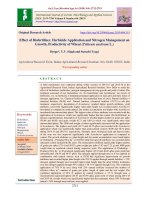


![Growth and yield of Ashwagandha [Withania somnifera (L.)] as influenced by different intercropping system in Kymore plateau of Madhya Pradesh](https://media.store123doc.com/images/document/2020_01/09/medium_vsb1578562778.jpg)

